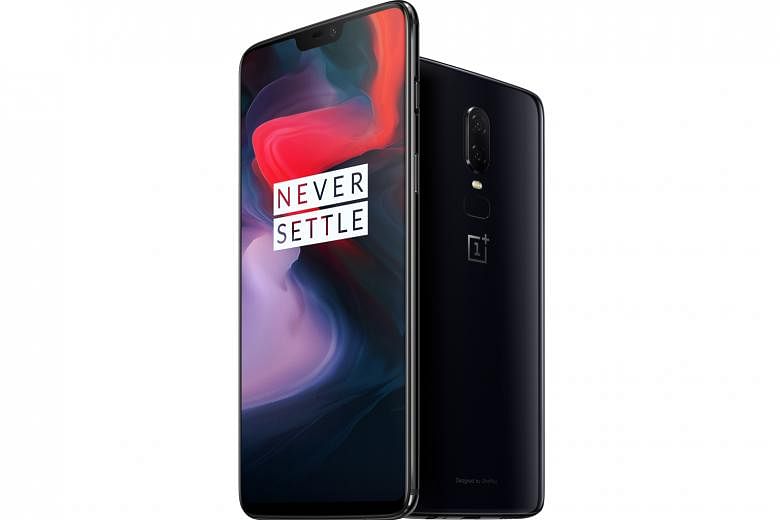OnePlus has often billed its phones as "flagship killers" that match the performance of top smartphones from big brands, but at a much lower price.
This approach fits the David versus Goliath, plucky start-up narrative pushed by OnePlus, even though it is backed by BBK, the electronics giant also behind Vivo and Oppo.
But to catch up with premium smartphones that are becoming better and more pricey, OnePlus has had to raise prices too. The new OnePlus 6 costs slightly more than its predecessor, though it is equipped with Qualcomm's best Snapdragon 845 processor.
However, it is not the most affordable smartphone with this chip. The Xiaomi Mi Mix 2S ($699) is cheaper than the OnePlus 6, which starts at $868.
To be fair, the OnePlus 6 has a more costly Oled screen than the Mi Mix 2S' LCD screen. But compared with top flagship phones, the OnePlus 6 still lacks some features such as wireless charging. It is not certified for water resistance. There is no microSD card slot either.
On the other hand, it has a 3.5mm headphone jack that has been dropped from many phones. I was not impressed with its single, bottom-firing speaker, which sounded hollow and thin.
-

SPECS
PRICE: $868
PROCESSOR: Qualcomm Snapdragon 845 (Quad-core 2.8GHz, quad-core 1.7GHz)
DISPLAY: 6.28-inch, Amoled, 2,280 x 1,080 pixels, 402 ppi pixel density
OPERATING SYSTEM: OxygenOS 5.1.9 (Android 8.1)
MEMORY: 64GB, 6GB RAM
REAR CAMERA: 16MP (f/1.7) and 20MP (f/1.7)
FRONT CAMERA: 16MP (f/2.0)
BATTERY: Non-removable 3,300mAh
-
RATING
FEATURES: 4/5
DESIGN: 4/5
PERFORMANCE: 5/5
VALUE FOR MONEY: 4/5
BATTERY LIFE: 4/5
OVERALL: 4/5
Its 6.28-inch display looks stretched with a 19:9 aspect ratio. It has narrow side bezels and a slim bottom chin. There is no front physical button - it uses virtual Android navigation buttons instead.
The sides are too thin for my liking, while its polished glass back is dangerously slippery. A protective case is recommended.
From the back, there is a pleasant symmetry about the phone. Its dual cameras are aligned vertically with a fingerprint sensor located right below them.
These dual cameras are very good, especially in the day. They focus quickly and have little shutter lag.
Photos turned out balanced and lively with good detail. The secondary camera, however, is neither a telephoto nor monochrome camera, so it seems to be there for the depth-of-field effect. To its credit, portrait mode or bokeh shots looked natural.
In low-light conditions, I was surprised that images turned out brighter than they appeared. Darker areas were slightly smeary, though the images were not as noisy as I had expected.
The front of the phone may cause some enthusiasts to groan. It has a notch like so many phones released this year. If you dislike it, the notch can be concealed by toggling a display setting to black out the sides.
The screen supports high dynamic range (HDR) videos that appear more life-like. So far, the HDR selection is limited to videos on YouTube, which look great on the phone. It does not support HDR videos on Netflix.
The OnePlus 6 also has Night and Reading modes that reduce the amount of blue light emitted for greater eye comfort.
I was pleased that it still has the alert slider - a physical slider at the side that I have not seen on other Android phones. This slider lets users conveniently toggle between Silent, Vibration and Ring profiles for calls and notifications, though you can tweak its behaviour slightly in the settings.
Generally, the phone's OxygenOS interface (based on Android 8.1) is very clean, with practically no bloatware. The interface feels responsive and quick.
In the Geekbench 4 system benchmark, the OnePlus 6 scored 9,092 for the multi-core segment. In comparison, the Samsung Galaxy S9+ managed 8,910, while the Apple iPhone X scored 10,144.
OxygenOS is not merely stock Android because OnePlus has introduced some handy features. They are turned off by default so you do not have to use them. For instance, you can swipe with three fingers to take screenshots or long-press the fingerprint sensor to take a photo.
I also found the Shelf, a custom screen accessed by swiping to the left of the Home screen, rather helpful. It shows your most recent contacts, apps and the weather.
OnePlus uses a proprietary fast-charging technology for its phones. It works only with the bundled power charger, but it is really fast. It took slightly more than an hour to charge a fully depleted OnePlus 6 to 100 per cent.
Its battery life is very decent at about 12 hours 40 minutes in our video-loop battery test. And even if you do not charge it at the end of the day, its fast-charging feature means you can get it up and running quickly the next morning.
• Verdict: The OnePlus 6 may be more expensive than its predecessor, but its performance, especially the cameras, will give flagship phones a run for their money.


